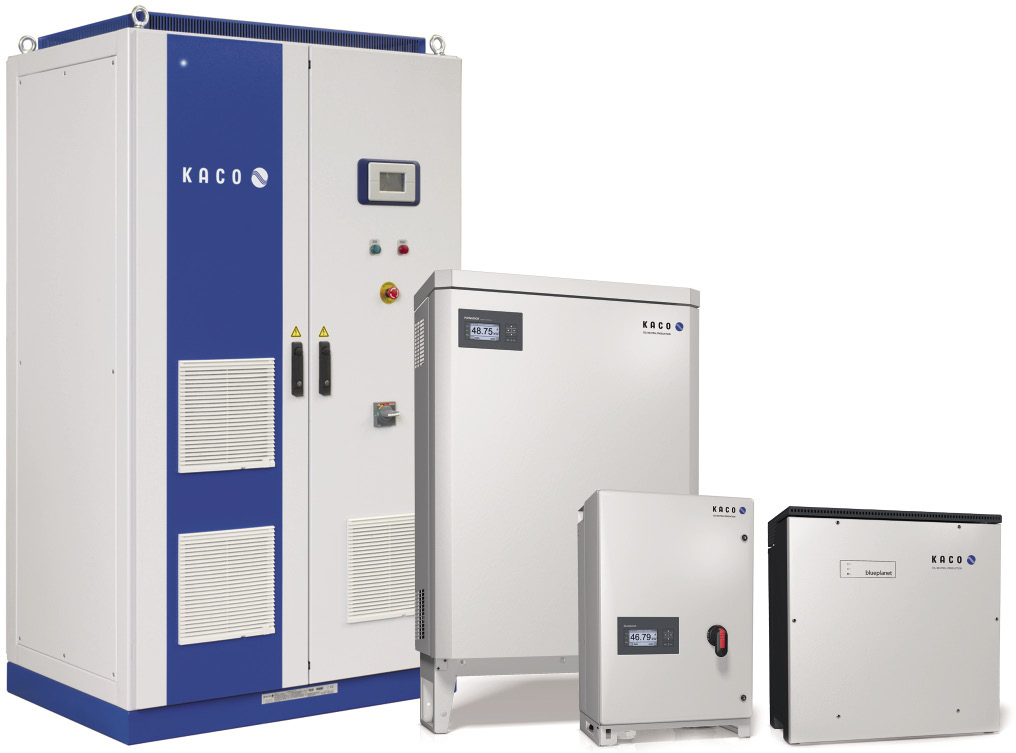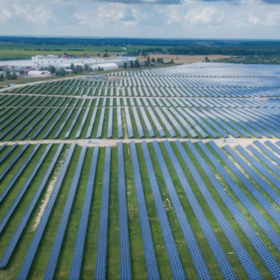From pv magazine, December edition
Matthias Haag is driven, but he keeps his cool. “We are forced to keep developing new innovations,” he says. The CTO of Kaco New Energy estimates that what he and his team have put forward gives him three quarters of a year to a full year’s head start.
Kaco decided three years ago to develop a new device in the large string inverter segment that would close the gap with central inverters and is now marketed under the name Blueplanet 125 TL3. The targets the engineers set seemed ambitious at the time. The capacity should be more than 100 kilowatts, but the unit should not weigh more than 80 kilograms. “Because when you install it in remote regions, it should be possible for two people to carry it and mount it,” says Haag.
There are several concepts that achieve this goal. One is to use silicon carbide instead of silicon as the semiconductor for the electronic switches. The concept has been known for quite some time, and Fraunhofer ISE even presented a sample in 2010. Refusol also exhibited a device at Intersolar 2012. But the procurement of silicon carbide components has long been considered too uncertain and far too expensive. This is now changing, as silicon carbide is also in demand for applications in electric cars, and quantities are rising.
Kaco is now one of the first manufacturers to introduce a product based on silicon carbide produced in series. In 2019, the Blueplanet 125 TL3 will be delivered in five-figure quantities. Because this is a necessary step to put into practice an innovation that will make solar energy cheaper and easier to implement in the future, the product has been awarded the pv magazine Deutscland top innovation highlight.
How the innovation began
Kaco engineers have been working on a research project with silicon carbide metal-oxide semiconductor field-effect transistor (MOSFET) switches for five years. When development of a new device began, they ultimately opted for the new technology. “In the past, silicon carbide components were up to ten times more expensive than their silicon counterparts,” Haag explains. Now prices have fallen by 30 to 50%. This lower price difference can be offset by cutting costs in other areas.
For the new development, Infineon was responsible for the module with the semiconductor components. Kaco’s job was to ensure optimal placement on the printed circuit board, interconnection with the choke coils, and measurement of the prototype. The real art is managing the high power over the printed circuit board, says Haag. Nevertheless, more than 130 amps are combined in two switching modules, each about half the size of an iPhone.
The complexity of the circuit design is also due to the fact that the strengths of silicon carbide only become apparent when the inverter’s switching frequency is particularly high. The new device now chops the direct current at 48 kilohertz before using the coils to generate a smooth 50 hertz sinusoidal alternating voltage. Haag notes that this high clock frequency creates new phenomena.
If conductor paths are not arranged optimally, interference occurs because the conductor paths behave like tiny antennas at this frequency. The frequency of 48 kilohertz was intentionally selected so that the third harmonic would be below 150 kilohertz. Ultimately, this makes it easier to comply with electromagnetic compatibility guidelines.
The high switching frequency makes it possible to reduce the size of the choke coils that are found in lower frequency devices, cutting their weight by more than half and their cost by just under half of those in comparable inverters with the usual clock frequency for silicon components.
Furthermore, since conduction losses in silicon carbide are lower than those in silicon, less heat has to be dissipated which also shrinks the size of the heat sink. Altogether, this makes a smaller housing possible. Just how relevant this is can be demonstrated by the fact that chokes, heat sinks, and housings still account for more than half of the overall weight of the device.
An industry-wide trend
Since Infineon can now also sell the switch module to other manufacturers, Kaco has to hurry to exploit its development lead. Kaco estimates it has roughly a nine to twelve month head start, since inverter manufacturers not only have to buy the switch module from Infineon but also develop the printed circuit board (PCB) layout.
SMA has already announced the launch of a similar device for early 2019. According to the inverter manufacturer, it has already built hundreds of prototypes and carried out long-term tests with this technology over the past ten years. These were necessary because the reliability of the silicon carbide MOSFETs had previously been viewed with skepticism. In 2012 SMA even produced a small batch of devices with the technology. At the time, however, it was not economic to do so.
In the future, the benefits of silicon carbide technology are likely to become even greater. “It has more development potential,” says Haag. “While silicon semiconductors have undergone numerous optimization steps over the past thirty years, the learning curve for silicon carbide is still in its infancy, and the cost reduction potential is greater. In addition, the higher electric strength of silicon carbide compared to silicon semiconductors is more important for 1,500 volt systems, and their market share is likely to increase in the coming years. There are now many reliable supply sources for silicon carbide MOSFETs in Europe, the USA, and Asia, writes Andreas Hensel, head of the medium voltage power electronics team at Fraunhofer ISE. The size of silicon carbide wafers in production has grown from four inches to six inches. At present, there are even initial approaches to the development of eight inch wafers.
These are all clear steps towards mass production and thus the continuing cost reduction of silicon carbide components. According to his assessment, silicon carbide technology will establish itself everywhere and become a fixed market component where high efficiency and compact design are system and cost-critical.
Other approaches
There are other approaches, however, to meet the objectives Kaco set out and achieved with the new device. Silicon semiconductors can also be used to increase frequency and reduce weight. One example of this is the Sungrow inverter, which has a comparable weight and volume. However, the efficiency is 0.3 percentage points lower than that of the silicon carbide device from Kaco. “We use a five-level topology,” says Sungrow. The company is already optimizing performance, efficiency, and heat dissipation.
Kaco CTO Haag sees the advantage of silicon carbide in the fact that it enables a topology that requires fewer switches and components than a five-level topology. This reduces the risk of failure and results in a higher thermal load capacity.
One indication, Haag explains, of this is that the derating of silicon carbide devices is lower; that is, its reduction in efficiency at rising operating temperatures. Depending on the location, this can bring higher yields. In addition, efficiency is generally higher. In the specifications comparison in the table, the Kaco device also scores best in efficiency.
ABB says it already has string inverters with silicon carbide technology in its product range, among them the 100 kilowatt plus string inverters it also exhibited this year. “Silicon carbide has already been in use for several years,” says Leonardo Botti, the head of product management. A product comparison shows some fundamental differences between the devices. The 175 kilowatt ABB device has a rated output power of 800 volts with 12 maximum power point trackers (MPPTs). The other devices have a maximum of
600 volts AC output and only one MPPT.
The number of MPPTs a company uses is a philosophical question to some extent. Kaco points to a study it conducted with Fraunhofer ISE to justify its approach of using just a single MPPT. According to the study, more MPPTs in large ground-mounted plants or large industrial building roofs do not result in higher yields unless very different shading situations are present.
According to Haag, anything gained by optimizing the operating point is lost in part due to the higher losses in the power electronics. If the additional MPPTs and the higher output voltage can only be achieved with additional step-up converters, it increases the number of components required. Kaco believes that increasing the number of components comes at the expense of efficiency and reliability, and its philosophy is to keep the equipment as simple as possible. This is one of the reasons why the company is now using silicon carbide MOSFETs.
This content is protected by copyright and may not be reused. If you want to cooperate with us and would like to reuse some of our content, please contact: editors@pv-magazine.com.








By submitting this form you agree to pv magazine using your data for the purposes of publishing your comment.
Your personal data will only be disclosed or otherwise transmitted to third parties for the purposes of spam filtering or if this is necessary for technical maintenance of the website. Any other transfer to third parties will not take place unless this is justified on the basis of applicable data protection regulations or if pv magazine is legally obliged to do so.
You may revoke this consent at any time with effect for the future, in which case your personal data will be deleted immediately. Otherwise, your data will be deleted if pv magazine has processed your request or the purpose of data storage is fulfilled.
Further information on data privacy can be found in our Data Protection Policy.